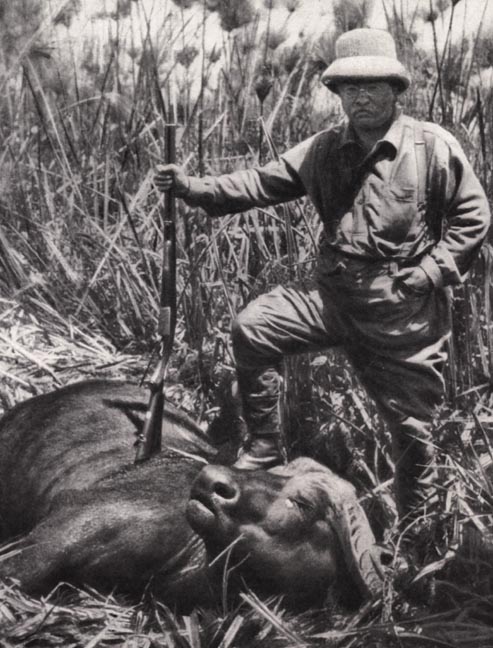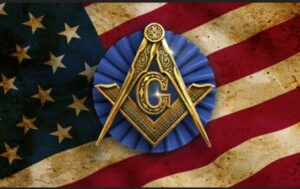Bully! In Search of the lost origins of the Mysterious Water Buffalo Head
By W:. Ronald J. Seifried, DSA

No current furnishing, artifact, or memorabilia has been discussed in Jephtha Lodge more than the mysterious African water buffalo head mounted on a second-floor wall. Some of the wild conspiracy theories include the long-held legacy than the mighty beast was hunted and killed by nearby resident and Brother Theodore Roosevelt and personally delivered to the Huntington lodge by the former President.
As our late Brother coined over one hundred years ago, “Bully!”
The Expeditions of Theodore Roosevelt
Our mystery commences in February 1915, when Theodore Roosevelt delivered a lecture entitled “My Masonic Experiences in South America and Africa” to his local masonic brothers residing near his home in Cove Neck. An invitation went out to the members of his own Matinecock No. 806 and their parent lodge, Jephtha No. 494 in Huntington. It is estimated over 30 Jephtha brothers from Huntington trekked over to Roosevelt’s home in Sagamore Hill, including one of his second degree examiners, R:.W:. Douglass Conklin for this exclusive gathering. While in Africa, Roosevelt did find time to visit a masonic lodge in Nairobi, in the British colony of Kenya, but the focus was clearly on his hunting exploits.
Roosevelt’s first expedition started just 19 days after the conclusion of his final term as President. Organized by the Smithsonian Institute to collect specimens for their new Natural History Museum, the small group was led by legendary hunter-tracker R. J. Cunninghame and set sail for East Africa on March 23, 1909. By the end of the trip over 10 months later, the team killed or trapped approximately 11,397 specimens, including 512 by Roosevelt and his son Kermit. Roosevelt kept a detailed diary of his adventures and later published the exact list of his kills in the book “African Game Trails.” The variety of big game personally hunted by the former president was extraordinary, including lion, leopard, cheetah, hyena, elephant, white rhino, the now exceedingly rare black rhino and ten buffalos-six by the former president and four by his son Kermit.
Roosevelt stated in his book, “Kermit and I kept about a dozen trophies for ourselves; otherwise, we shot nothing that was not used either as a museum specimen or for meat…the mere size of the bag indicates little as to a man’s prowess as a hunter, and almost nothing as to the interest or value of his achievement.” If Roosevelt’s claim that the family only kept one dozen for themselves is accurate, a tour through the Sagamore Hill home would count for most if not all these specimens.

Roosevelt later led a scientific survey expedition in South America between December 1913 to April 1914 to follow the path of the Rio da Dúvida in the Amazon basin. The problematic tour including many members coming down with malaria, poorly supplied food leading to starvation diets, one person drowning, one person murdered, and his accused killer left behind in the jungle to perish. Roosevelt himself was near death after having received a gash in his leg that later became infected. Roosevelt returned to New York greatly weakened and never fully recovering, dying at his Cove Neck home less than five years later. There is no record of Roosevelt hunting for buffalo in South America.
Roosevelt started giving lectures in May 1914 in part to silence the critics doubting he discovered the river and made the exhibition. These series of lectures included his invitation-only event to Oyster Bay and Huntington Freemasons in February 1915. Unfortunately, there are no known records of the lodge receiving a prized water buffalo head from Roosevelt.
A Forgotten Sale from a Coroner
But Roosevelt was not the only big game hunter to cross paths with Jephtha Lodge. On February 15, 1937, Jephtha Lodge took possession of nine taxidermied animal parts from Dr. William B. Gibson in exchange for one dollar of American currency. The list of stuffed animal parts included two large, mounted moose heads; two mounted deer heads; two mounted caribou heads; two mounted deer hoofs and one moose horn. The bill of sale was accepted by W:. Allison E. Lowndes, Past Master (1922) and longtime Trustee of Jephtha and filed in the archives by W:. Herman Chris Lorck, Secretary (1935-1944) and Past Master of Jephtha (1932).
There is no known connection between Dr. Gibson and Jephtha Lodge. He was not raised to the sublime degree of Master Mason, nor is there any record of a petition. There is also no recorded proof that Gibson hunted the mammals or if he acquired the pieces from an intermediary.

William B. Gibson (1855-1941) was born in Clarenceville, Quebec, Canada to Dr. John B. (b. Scotland) and Lucy S. Baker Gibson. In 1878, he obtained his medical degree from McGill Medical College (now McGill University) in Quebec. Gibson practiced medicine in London for one year, before returning to Dunham, Quebec. Between 1878-1885, he was an Assistant Surgeon of the 60th Canadian Regiment, obtaining the rank of Major in a commission signed by Queen Victoria. Appointed to the Medical Department at the University of Vermont in 1885, Gibson lectured on materia medica and obstetrics until 1889.
Gibson moved to Huntington, New York in 1891, living on 153 Main Street (1900 -1920) and 71 New Street (1930-41). Elected President of the Queens and Nassau Counties Medical Society and Associated Physicians of Long Island in 1901, Gibson was the Suffolk County Coroner for several decades. In 1880 he married Amelia Caroline Moore, and they had two sons, Gordon, and Frederick.
The big game trophies from the collection of Dr. Gibson have long vanished from the rooms of Jephtha Lodge. Although water buffalo is not listed as part of Gibson’s former collection, there is no evidence that his items were acquired in the African continent.
In Search of Additional Evidence
We can determine that the mounted head on the second floor is a water buffalo based on its horns growing slightly downward and backward, then curve upward in a spiral. More common in Asia, water or river buffalo, can be found in Egypt. But Roosevelt’s safari was in the sub-Saharan part of Africa, miles away from the northeast corner of Egypt and based on photographic evidence, Roosevelt only hunted cape buffalo.
The water buffalo was introduced in the Amazon river basin in 1895, which was part of Roosevelt’s 1913-14 exhibition. Because of the challenging South American survey trip, including almost facing death, it is not believed Roosevelt did any hunting in the continent during his three months stay.
The origin story of the old water buffalo staring out to curious onlookers with its glass eyes in the small second floor room will remain a mystery for the time being. It does not stop brothers from spinning tales to unsuspecting visitors that Jephtha Lodge’s connection to Long Island’s most famous freemason is more than a proficiency examiner and personal lecturer. The framed picture of the former president with one of his African prizes still hangs adjacent to the mounted head, with a black and blue masonic baseball cap on one of its horns. The evidence is not clear, but Jephtha lodge members can carry the infamous legacy forward as a distinct possibility if not a certainty, the TR Buffalo can retain its moniker.
The post Bully! In Search of the lost origins of the Mysterious Water Buffalo Head appeared first on Jephtha.com.

